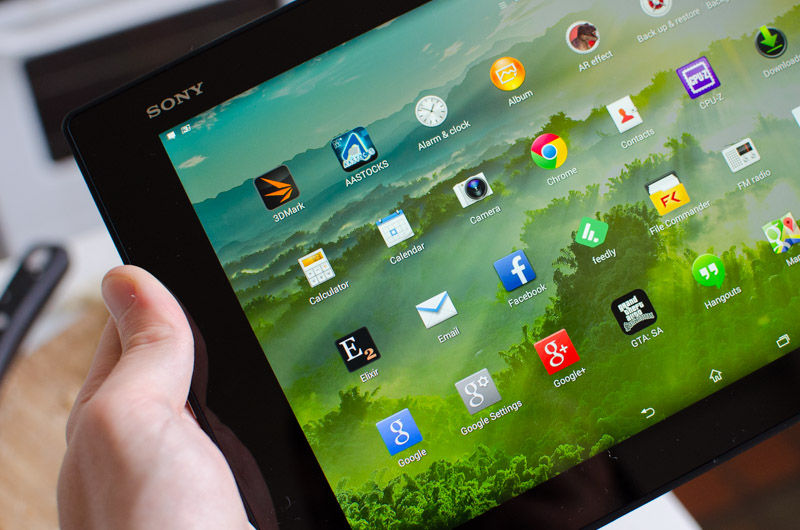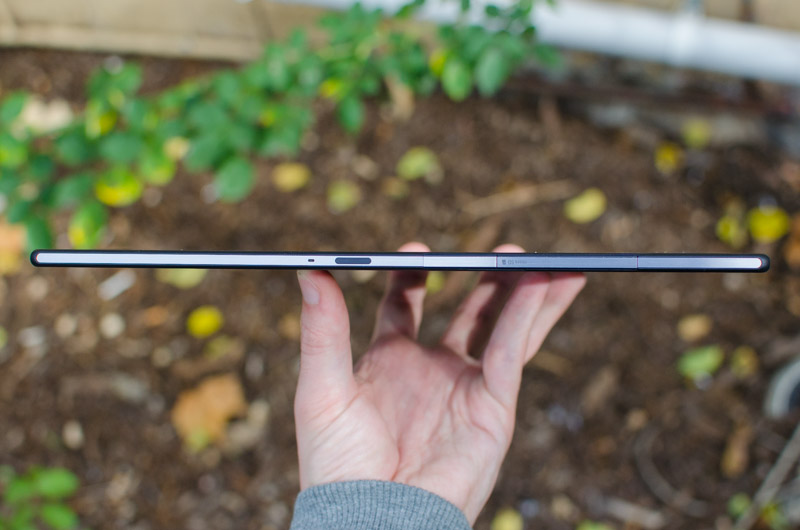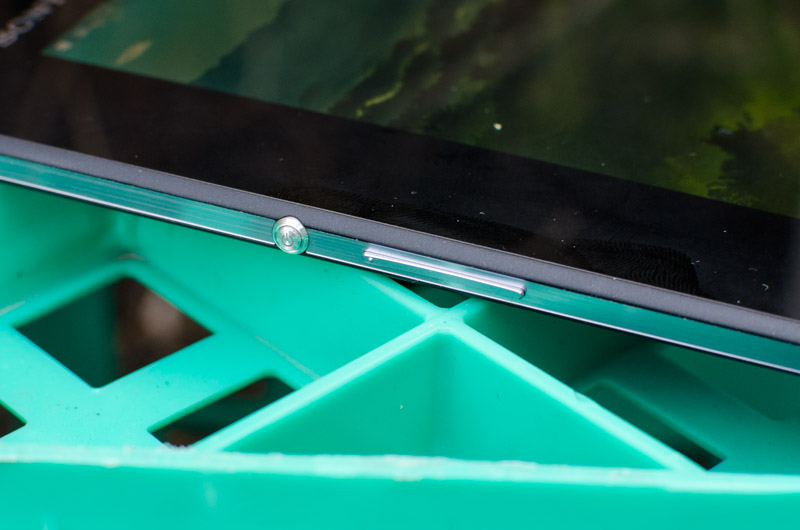Since the launch of the incredibly popular Google Nexus 7, the 10-inch Android tablet market has taken the backseat to smaller form factor devices. The more compact tablets are seen as less cumbersome, more attractive options for many users who just want to play a game or browse the web. There are a plethora of companies competing to steal the spotlight in the cheap 7- or 8-inch Android tablet market, while the Apple iPad mini continues to sell well in the higher end.
Those who prefer bigger tablets aren't left out in the cold though. Android OEMs like Sony continue to release high-quality products like the Xperia Z2 Tablet - which I'm taking a look at today - to pair with their flagship smartphones, but they still face tough competition from the iPad, and also from flexible and powerful hybrid Windows 8.1 devices.
The Xperia Z2 Tablet is a successor to last year's Xperia Tablet Z, and like what we're seeing in Sony's smartphone range, the device is an incremental update to what came before. Like the Tablet Z, the Z2 Tablet is fully water resistant, packs a 10.1-inch WUXGA display, and is under 7mm thick. The most significant update is the specification bump to Qualcomm's latest Snapdragon 801 SoC, plus there's an improved camera and a sizable weight reduction.
Sony Xperia Z2 Tablet: $499 - $639
- 10.1", 1920 x 1080 IPS LCD display (224 ppi)
- Qualcomm Snapdragon 801 SoC
- 2.3 GHz quad-core CPU, Adreno 330 GPU, 3GB RAM
- 16/32 GB internal storage, microSD card slot
- 8 MP camera, 1/4" sensor, f/2.4 lens, 1080p video
- IP58 water resistant
- 6,000 mAh, 23 Wh battery
- LTE (optional), Wi-Fi a/b/g/n/ac, Bluetooth 4.0, NFC
- Android 4.4 'KitKat'
- 439 grams, 6.4mm thick
So is the Android 4.4-powered Xperia Z2 Tablet worth the $500 asking price, or is it another largely-forgettable 10-inch tablet?
The Sony Xperia Z2 Tablet used in this review was provided by Expansys. Check them out for unlocked, off-contract devices at great prices, with fast shipping around the globe.
Design
The highlight of the Xperia Z2 Tablet is definitely the design, which could be the best I've seen on an Android tablet to date. Sony has largely used the same design language as seen on their Xperia Z smartphones but adapted for a larger and thinner form factor, and it works to perfection.
Click on any photo to enlarge
The thinness is striking from the moment you take the Z2 Tablet out of the box. At just 6.4mm thick, the device is beautifully crafted and feels fantastic in your hands, complemented by a light (439 grams) construction that keeps the tablet portable. Compared to a machine like Microsoft's Surface 2, the Z2 Tablet looks slender and unquestionably fantastic.
Build-wise, the Xperia Z2 Tablet is as fantastic as I've come to expect from Sony's high-end devices. The front panel is an all-glass affair that makes the screen a breeze to use, while the back turns to a soft-touch plastic to protect the internal hardware. On Sony's smartphones we've seen a glass back panel that looks great, but this doesn't make as much sense on a tablet due to the fragility and weight of the material, so I'm perfectly happy with the plastic used.
Unlike some plastic implementations (looking at you, Samsung), the Xperia Z2 Tablet's rear panel doesn't look awful, in fact it fits in well with the rest of the slate. Unfortunately it's a massive fingerprint magnet in black that's tougher to clean than the front, but its minimalist design looks good and it feels great to caress. Around the edges there's silver brushed metal highlights, which add visual appeal to the package.
One thing I'm not a huge fan of is the sizable bezels around the 10.1-inch display, which make the screen look smaller than it is. There's enough room on the front to fit a 12-inch panel, albeit with no bezel, so Sony could easily have added an 11- or 10.6-inch display in an ideal configuration. The bezel is especially large width wise, far larger than what's necessary to keep palms from interfering with the touchscreen.
In keeping with Sony's past few devices, the Xperia Z2 Tablet is fully IP55 and IP58 water resistant, indicating it's protected against low pressure water jets and capable of withstanding submersion in 1.5m of fresh water for up to 30 minutes. It's also protected against the ingress of dust, for what it's worth.
Like all waterproof devices with a capacitive touchscreen (eg. the Samsung Galaxy S5), it's impossible to use the touchscreen when the tablet is fully or partially submerged in water. This significantly reduces the usefulness of this feature, especially when considering how it's unsafe to submerge the tablet in salt water due to the risk of corrosion.
The best reason I can come up with for wanting a waterproof tablet is that you can use it in the bath without fear of ruining it should you accidentally drop it into the water. Similarly, there's no fear of split water or other liquids destroying the tablet. However, its lack of resistance to salt water makes it a bad decision to take the Z2 Tablet to the beach, and it's essentially useless underwater.
Yes, you can take photos underwater using the volume rocker, but you'll look pretty stupid using a tablet for any sort of serious photography.
The effort to waterproof the Z2 Tablet has some downsides to it, mainly the flaps along the top edge of the device that protect the microSD card slot and micro-USB port from water ingress. These flaps are much harder to open than their smartphone counterparts on the Xperia Z1, which is annoying whenever you want to charge the device.
The flap for the microSD card slot is fairly large, and appears to also house a spot for the SIM card slot if this were the LTE-capable version of the tablet. Also along the top edge you'll find the IR LED for controlling TVs.
Around the other edges of the tablet there's the circular power button and volume rocker mid-way down the left side, while there's nothing on the right. The bottom sees the 3.5mm headphone jack tucked into the very left corner, and in the middle is Sony's typical magnetic dock connector.
Hidden along each side of the front panel you'll find stereo speakers, which are acceptable quality for a tablet and capable of providing a decent volume. Stereo speakers are really critical on a media-centric tablet like this, and I'm always glad whenever a company decides to include them.
Display
The Z2 Tablet packs a 10.1-inch IPS TFT LCD display with a resolution of 1920 x 1200, branded as "Triluminous" featuring the "X-Reality picture engine" and "Live Colour LED". Basically these marketing terms - which Sony has used before to describe their Xperia smartphone displays - refer to the panel's wide color gamut, software processing engine, and uniform LED backlight respectively.
The Z2 Tablet's display is essentially a larger version of the Xperia Z2's display, meaning color reproduction and viewing angles are the same as their latest flagship smartphone. This results in a generally fantastic display that's great to look at, producing vivid colors with a decent level of depth and contrast.
The Live Colour LED backlight delivers an accurate white level and helps the display achieve a wide color gamut. It appears the gamut of the panel is wider than sRGB, so there will be some color stretching as Android lacks color management tools, resulting in a slightly inaccurate image compared to a panel that displays the exact sRGB spectrum. That said, images on the Xperia Z2 Tablet look great and I don't think accuracy will be a huge concern for most consumers.
In terms of pixel density, the 10.1-inch display with an area of 296 square centimetres and resolution of 1920 x 1200 boasts a density of 224 PPI, which is typical for a current generation tablet of this size. Holding the Xperia Z2 Tablet at a typical viewing distance makes it hard to distinguish individual pixels, making text look crisp and clear. Higher resolution 10-inch displays do exist - we saw 2560 x 1600 on the Google Nexus 10 - but I'm perfectly content with the Z2 Tablet's WUXGA panel.
With a resolution just larger than 1080p, you'll be able to watch Full HD content natively with a small amount of letterboxing, which is typical for an Android tablet. Factoring in the navigation bar at the bottom of most apps, the usable display resolution reduces to 1920 x 1128: just shy of standard 1080p.
The Z2 Tablet's display is bright and somewhat readable outdoors, although the glossy glass panel can be reflective if you are trying to view the display directly in front of a strong light source. Luckily the viewing angles from the IPS-class LCD are very good, with Sony clearly putting work into an area of their displays that hasn't been a strong suit in the past.
The X-Reality engine is a software feature that you can enable in the Xperia Z2 Tablet's settings, boosting the color saturation, increasing contrast and sharpening images in certain applications. The implementation appears to be identical to previous Sony devices, whereby it only enhances images in the stock Gallery and Videos apps, and can occasionally give oversaturated results.
Turning the feature on does make photos look better in some circumstances, but I tend to prefer accuracy so I usually switch it off. I'd like to see the X-Reality engine take effect over the entire operating system when enabled, not just some first-party applications, but Sony is sticking with the usual implementation. On the other hand, the white balance setting (which is identical to the one found in the Xperia Z1 Compact) does affect the entire OS if you want to fiddle with how your display looks.














